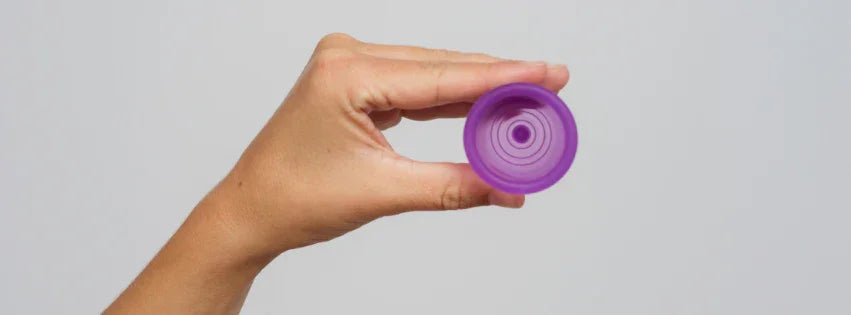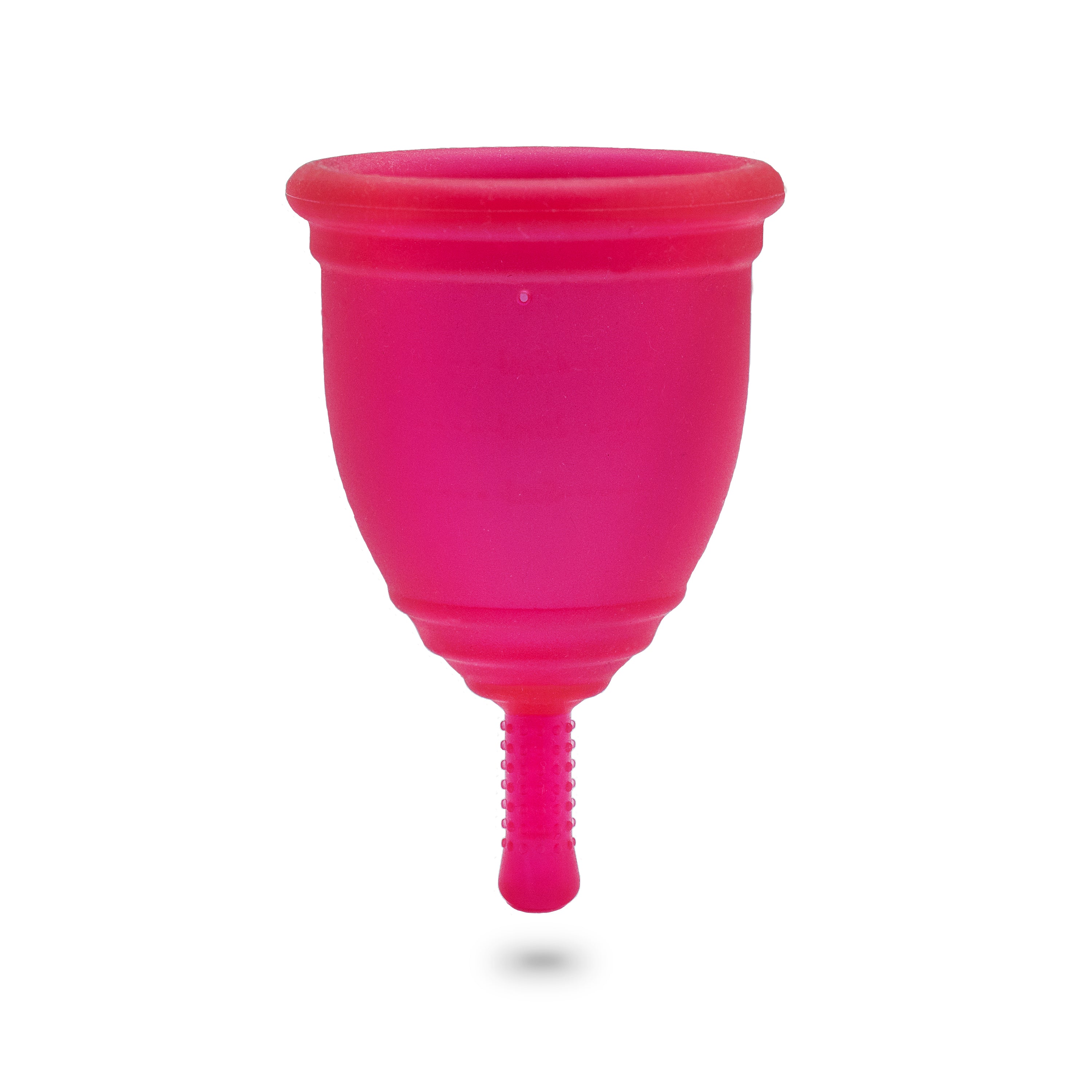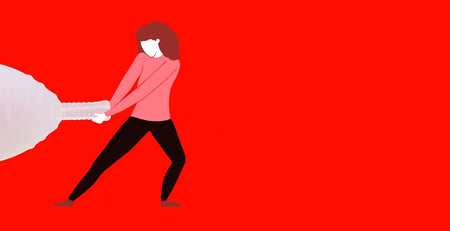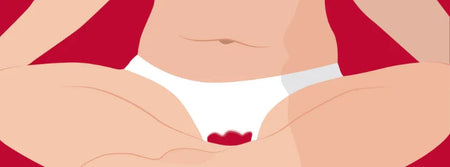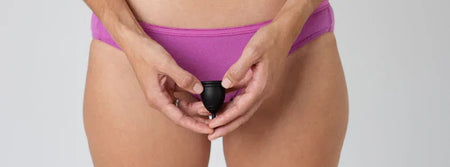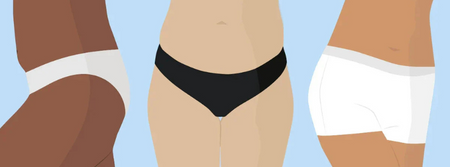This article is written by medical professional Amy Harris, whom you can read more about at the end of the article.
There are a lot of reasons you want to stop using pads and tampons. Whether you're environmentally conscious, allergic to traditional period products, find them uncomfortable, or just looking to save money, there are plenty of reasons to make the change.
But making a lifestyle change is scary and it’s not made any easier by the range of options out there. Both menstrual cups or discs could be the answer to your problems but you might be unsure how to use them, whether they're safe, and what the differences are.
So, when comparing a menstrual disc vs cup, which is better?
If you're on the fence, you've come to the right place. While we’re specialists in menstrual cups, Ruby Cup’s mission is to advocate for healthier, sustainable period products for every person who menstruates, no matter their income. This is why we have a Buy One Give One model, funding educational programs, and providing resources to end period poverty around the world.
With that mission in mind, we’re going to give you unbiased facts about menstrual cups and discs in this medically reviewed article so you can make a choice that’s right for you.
Read on to discover how to use a menstrual cup and disc, the potential risks involved, and if one is better than the other.
Want a zero-waste and fuss-free period? For every Ruby Cup purchased, we donate another one to a person without access to safe menstrual products. Get your Ruby Cup now.
What is a menstrual cup?
Let’s start by talking about what a menstrual cup is. A menstrual cup is a flexible, reusable cup-shaped period product that sits just below your cervix in your vaginal canal and collects your period blood. Unlike tampons, menstrual cups don't absorb your blood. And a cup won't leave you feeling sticky, itchy, or uncomfortable like a pad.
A menstrual cup holds more blood than tampons or pads, making it the best zero-waste option. For example, a Ruby Cup can last up to 10 years, making it a more eco-friendly choice when compared to single-use, disposable period products, including disposable discs. And it's easily cleaned with water during your period, while a 3-minute bath in boiling water will sanitize it between periods.
What is a menstrual disc?
A menstrual disc sits higher in the vaginal canal, right under the cervix. Menstrual discs also collect period blood, but in a soft bag that hangs down from a flexible ring made from medical-grade polymer. This polymer heats up to your body temperature and becomes more bendable, fitting to the shape of your body. Discs are often disposable, single-use products, but also hold more blood than pads or tampons.
Menstrual disc vs cup: Placement
Before you experiment with both cups and discs, know the correct placement of each.
A menstrual cup rests lower in the vaginal canal. When you insert the cup and it pops open, its soft silicone rim will create a seal of suction to hold it in place. However, if you have a low cervix, your menstrual cup might sit right underneath your cervix. See our cervix-measuring guide below and try our sizing guide to discover which cup is best for you as well as the best menstrual cup for beginners.

A menstrual disc, however, is a bit different. If you're used to wearing a diaphragm, then using a menstrual disc will be easy. Like a diaphragm, a disc cups into place below the cervix, wedged between your pubic bone and your vaginal fornix, the backside of your cervix. The disc's spring-like band fills this area, making it leak-proof and stable without suction.

Related post: Menstrual Cups vs Reusable Pads: the Best Zero Waste Option
Menstrual cup vs disc: Material
Cups and discs are not all created equal. Most cups are made from medical-grade silicone, like the Ruby Cup, but rubber or latex are also used occasionally. Menstrual discs are made from silicone or a combination of body-friendly polymers of plastic and resins. Most discs are disposable, making them a less eco-friendly option than cups.
For the best eco-friendly and money-saving choice, a reusable menstrual cup will last you longer than the reusable menstrual disc options. For example, the reusable Ziggy silicone disc is priced similarly to a cup but only lasts two years, while Ruby Cup can last up to ten.
Whichever product you choose, always make sure it adheres to recognized health standards and is hypoallergenic. If you think you're allergic to any of the materials, consult a physician. And, if you use a lubricant while wearing a disc or a cup, choose a water-based one, as a silicone-based lube will damage a silicone cup or disc.

Menstrual cup vs disc: Insertion and removal
We know what you're thinking. How can you insert and remove a menstrual cup or disc comfortably inside you? They look too big to fit and too clumsy to handle. Yes, they both have a learning curve and you may need a couple of months before you get used to them. Rest assured, each is designed to fit comfortably inside your body.
Remember to practice good hygiene and always wash your hands before insertion and removal.
How to insert and remove a menstrual cup
The soft silicone of a menstrual cup makes it easy to fold and insert into your vagina. But there’s more than one way to fold a menstrual cup, so let's take a quick look at the different types:
The c-fold:

The 7-fold:

The punch-down fold:

Once your fold is ready, insert the cup into your vagina, then release the fold. The cup will pop open, its lips creating a seal against your vaginal wall, and hold itself in place.
To remove your menstrual cup, break its seal. You can either pinch the cup's base or insert a finger between the cup and the vaginal wall to release the suction. Next, pull down using the cup's stem, allowing for a steady, clean removal to empty the blood into the toilet.
Watch these fun videos to learn more about inserting and removing a menstrual cup:
How to insert and remove a menstrual disc
A menstrual disc is wider than a cup, so you'll need to pinch the disc in half, creating a long, thin oval. Then insert the pinched disc and push it up into your vagina like you would a tampon. When it's high enough, use one finger to slide the back rim into your vaginal fornix, the widest part of your vagina. Finally, tuck the front rim behind your pubic bone.
The rim will spring open, fitting into place. You should not be able to feel the menstrual disc once it is in place. If it feels uncomfortable after inserting it or moving around a bunch, then it might not be inserted high enough into your vaginal canal.
To remove a menstrual disc, hook a finger around the rim and pull it down. Yes, disc removal is messier than cup removal—the blood will get on your hands and flow out of your vagina before you're able to remove it. But emptying a disc in a public bathroom might be easier than a cup as you can tip it to empty the menstrual fluid while on the toilet without complete removal, then push it back into place.
Removing a disc can be trickier than removing a menstrual cup because studies show a higher rate of disc users going to their gynecologist due to experiencing problems removing it.
Are there any risks to using menstrual cups or discs?
Worries about risks are normal, especially if you've never used alternative period products. So let's address your concerns to help you make fear-free decisions.
- Leakage: Leaks can happen, but only when your cup or disc is out of position, or if you haven't emptied it when it's full. For more tips, check out our guide on what to do if your cup is leaking.
- Pain: Experiencing pain during use may indicate that your cup or disc is in the wrong position. So try to reposition it. Or if you're a beginner, you might be nervous and contracting your pelvic muscles, which can cause painful insertions or removals. Try different positions, such as squatting or resting one foot on the toilet. Or use a water-based lubricant with a cup or disc during your first few menstruations. A lubricant won't interfere with placement or suction and will create a more pleasant experience during the learning curve.
- Removal: The learning curve also applies to cup or disc removal, especially for first-time users who may think their cup or disc is stuck. But don't worry, cups and discs can't get stuck. For menstrual cups, follow our tips mentioned above or this complete guide. However, first-time disc users might find removal more difficult as current data shows a higher rate of disc users going to their gynecologist for disc removal.
- Allergies: Most cups and discs use body-safe materials like the Ruby Cup's medical-grade, soft silicone that's free from any plastic, latex, or bleach. But always consult the manufacturing label for potential allergic reactions to the materials used. When in doubt, err on the side of caution and consult your healthcare provider first.
- Infections: Practicing good hygiene is a must for preventing infections and research proves that cups and discs don't affect your natural vaginal flora. However, know that menstrual discs have the same placement as diaphragms, which are known to put people at risk for urinary tract infections.
- Toxic Shock Syndrome: Even though a few people have reported TSS with cup and disc use, current studies show no direct correlation between the two. The risk of TSS is very low when using either cups or discs, whereas there is risk associated with tampons.
How long can you wear menstrual cups and discs?
Current research on menstrual cups and discs does not take into account wearing time. However, you can wear both discs and cups at night, and how often you empty your cup depends on your menstrual flow. At Ruby Cup, we recommend emptying your period cup every 8 hours for safe and healthy cup use.
Which is better at handling heavy flow, menstrual cups or discs?
If you have a heavy flow, you're probably a super-tampon or maxi-pad user. So it's only natural to worry that cups or discs won't manage as well. The good news? Both cups and discs collect heavy menstrual flow better than traditional products.
According to The Lancet, a menstrual cup or disc can hold 10–38 ml of blood, or 2 teaspoons to 2 tablespoons, double the capacity of a super tampon. But let's put things into perspective here. The maximum amount of normal blood lost during a heavy-flow menstrual cycle equals 80 ml or a third of a cup measure, so both menstrual cups and discs can handle those deluge days with no problem, beating both pads and tampons.
For example, the Ruby Cup medium can hold up to 34 ml of blood, which is perfect for heavy periods. Uncertain about the size? Start with Ruby Cup's Duo Pack and experiment with two sizes.
Menstrual cup vs disc: Doubts dispelled
There's a lot of talk about cups and discs. So let's quiet some of the noise and answer your most pressing questions.
Do menstrual cups or discs reduce cramps?
Both menstrual discs and cups sit in your vagina, but cramps come from your uterus muscles contracting. Though many reviewers claim that menstrual cups and discs have improved period pain and reduced cramps, there is no scientific evidence to back this up.
Can you use menstrual cups or discs with a tilted uterus?
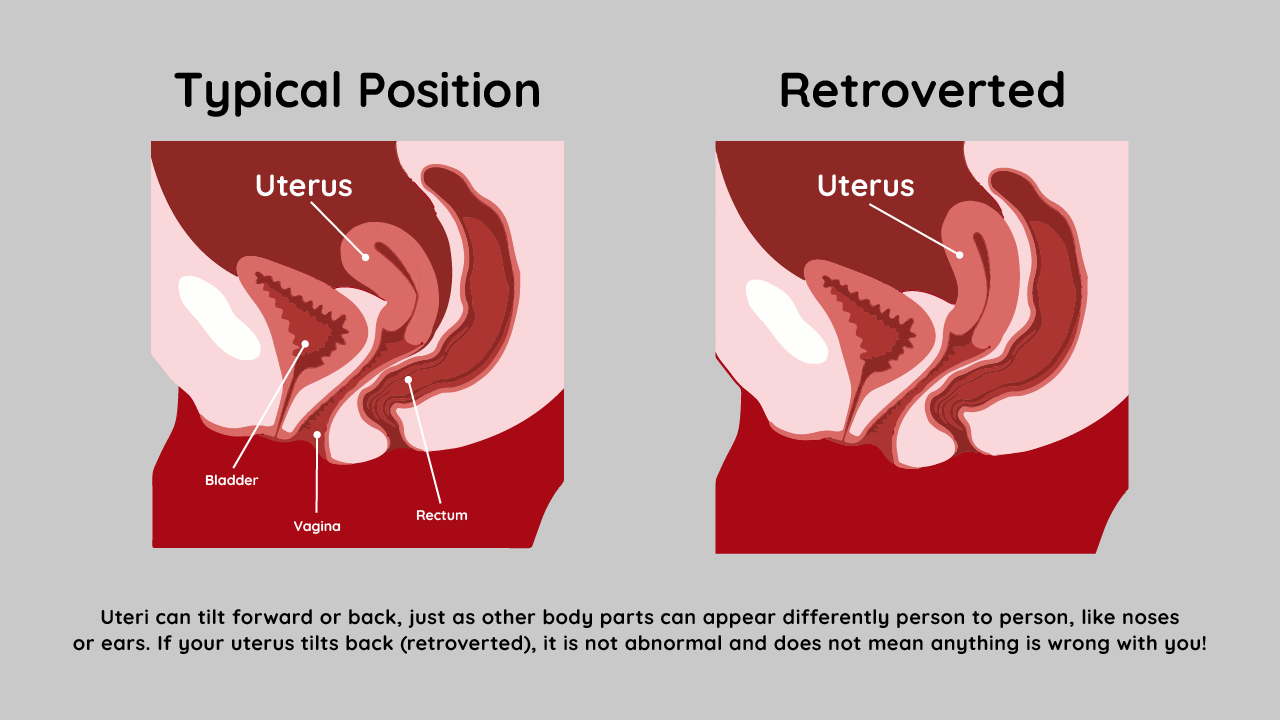
If you have a tilted uterus, one that tips backward instead of forward over the vagina, you might have concerns about switching to a menstrual cup or disc. But you can use both cups and discs comfortably once you know these facts and tips:
- Tilted uterus: Did you know that every 1 in 4 people has a tilted uterus? So, relax, this is normal.
- Cervix position: Did also you know your cervix changes positions during and after your period due to hormonal fluctuations? So if you find that your cervix has moved from one day to the next, this too is normal.
- Do what feels good: People with a tilted uterus tend to have a low cervix. If you experience pain with cup use, the cup might be too close to your cervix. Try using a smaller menstrual cup that's positioned lower in your vagina.
- First-time users: If you experience leaking with a tilted uterus, try a water-based lubricant to help move your cup or disc around until you find the right position to stop the leaking.
Not sure you have a tilted uterus? Check with your gynecologist, who can also show you your cervix to increase your body knowledge.
Related Post: Your Menstrual Cup Keeps Sliding Down? Here’s What to Do
Can you have sex while using a menstrual disc or cup?
Sex is one of the key differences between menstrual discs and cups.
You can have penetrative sex with a menstrual disc, which sits at the highest part of your vaginal canal just under the cervix, much like a diaphragm. Most people and their partners don't feel the disc and appreciate having mess-free period sex. But beware, even though a menstrual disc sits below the cervix like a diaphragm, it doesn't mean it's a reliable form of birth control.
You can’t have sex with a menstrual cup because of lower placement inside the vaginal canal and its longer bell shape.
Can you use menstrual cups or discs with an IUD?
You can use both menstrual cups and discs with an Intrauterine Device because an IUD sits in the uterus while a menstrual disc or cup sits in the vaginal canal. Even though there are a few cases of IUD expulsion with menstrual cup usage, there’s not enough data to show that using a menstrual cup increases the risk of dislodging your IUD. But it's good to be aware of a few facts:
- Timing: Wait at least 6 weeks after IUD insertion before using a cup or disc. It can take some time for your uterus to adjust to having an IUD. The first six weeks are the time when most women expel their IUDs.
- Strings: Since the strings of an IUD hang down into your vaginal canal, consult your gynecologist, who may decide to shorten the strings to better accommodate a menstrual disc or cup.
- Cup/disc placement: Even when shortened, IUD strings still hang down into your vaginal canal. Make sure they sit in the very center of your cup or disc without touching the sides or base.
- IUD placement: Always check your IUD strings after removing your cup or disc to make sure they hang in the same place and haven’t dislodged.
- Cervix: If you have a low cervix, use a smaller cup placed low in the vaginal canal. You can even trim the stem of a Ruby Cup to place it lower in your vagina more comfortably.

Related Post: Where Should a Menstrual Cup Sit & How to Insert It
Can you use a menstrual cup or disc after pregnancy?
You can use a menstrual cup or disc after giving birth. However, wait at least 6 weeks after delivery before using either a menstrual cup or a disc, and always consult your healthcare provider beforehand to make sure you're physically ready. You might also need a bigger cup after giving birth.
Menstrual cups and discs compared
Menstrual cups and discs are very similar, with a few key differences. Here's a handy summary of menstrual cups vs discs:

Menstrual cup vs disc: Knowledge is power
Now that you've learned about menstrual discs vs cups, you can make an educated decision on which alternative period product to choose—and start using the one that’s right for your lifestyle.
You may find one product isn't better than the other. Or you may discover you like wearing a cup at night, a disc during the day, and either a smaller cup or a period panty during light days. It’s good to know your options!
Only you will know what works best for your body and when. So be brave, be smart, and be safe, and make the change towards a more comfortable, cost-effective, and eco-friendly period today.
Want a zero-waste and fuss-free period? For every Ruby Cup purchased, we donate another one to a person without access to safe menstrual products. Get your Ruby Cup now.
FAQ on menstrual disc vs cup
Still on the fence? Here are some answers to the most frequently asked questions about menstrual discs vs cups.
Which is better, menstrual cup or disc?
Choosing a menstrual cup or disc is a personal choice. If you're unsure which to choose, test both. Use them at night, when you exercise, and on heavy and light-flow days to see which works best. The key differences are that cups are more eco-friendly because they're reusable and less messy to remove, while discs will allow for period sex.
Are menstrual discs easier to use than cups?
Menstrual discs require more body knowledge than cups. For example, if you already use a diaphragm, using a menstrual disc will be easier than a menstrual cup. However, if you feel squeamish about getting up close and personal with your vagina and cervix, try using a menstrual cup, which sits lower inside the vagina than a disc.
Can you sleep with a menstrual disc?
You can safely and comfortably sleep with a menstrual disc. Since the menstrual disc sits below the cervix and collects period blood without leaking, there are no risks involved during night use. Remember to empty your menstrual disc as soon as you wake up in the morning.
Are menstrual discs messy?
Menstrual discs are messier than menstrual cups. Cups have a stem for more steady handling without the risk of tipping the cup during removal. Discs, however, must be hooked by your finger and will partially collapse as you pull them down your vaginal canal. This change in shape can cause some menstrual blood spillage before complete removal.
Are menstrual cups and discs reusable?
Most menstrual cups are reusable while there are very few reusable menstrual discs, and most disc manufacturers suggest replacing a reusable menstrual disc every 1-2 years. Instead, some of the best cups, like Ruby Cup, can last up to 10 years, while most discs are disposable, single-use products.
Reviewed by Amy Harris. Amy Harris is a certified nurse-midwife with more than a decade of clinical experience in reproductive health clinics, hospitals, and private OB/GYN practices. Amy holds a Masters of Science in Maternal and Child Health from Harvard School of Public Health and completed her nursing and midwifery training at Yale School of Nursing and Boston University School of Public Health. Passionate about empowering women through health education, Amy puts her public health training to work as a dedicated women’s health writer.


